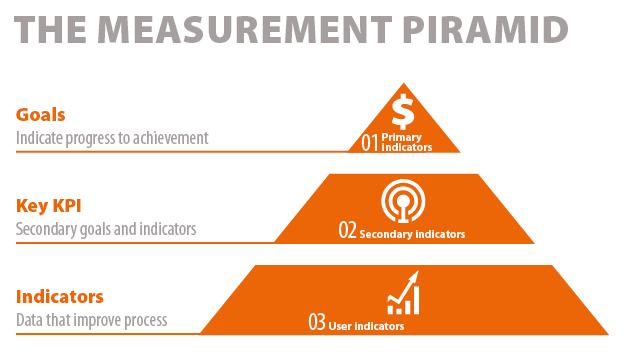
Google Analytics is a weapon of mass delusion – claims Robert Rose. It’s a way of making anything look like a massive failure or a massive success depending upon your agenda. – If you give me Google Analytics I will make it say anything you’d like me to say. As a marketer, you know how to make Google Analytics say anything. More traffic on the site? Of course it’s relevant traffi,we need that traffic. More time on the site? Of course they’re engaged with our content. It’s not that they can’t find what they’re looking for and they’re clicking around trying to find it, it’s that they’re more engaged, they’re reading it in-depth depth.
So how do we get to measurement with content marketing that really makes sense? Robert Rose suggests an idea, which, together with Joe Pullizzi, introduced in the book Managing Content Marketing. We call it the measurement pyramid.

We tier measurement into three different strata. One, goals. Which indicate progress toward our success. These are the primary indicators. Two, key KPIs, Key Performance Indicators. These are the secondary goals. These are all the things that we know about, but we’re not necessarily reporting. Three, are the tertiary indicators or user indicators, which are down to the individual level. These are likes, and follows,and page views. All the things that basically have our thumb to the wind to help us understand how the wind is blowing, but not necessarily things tha tare going to get reported on.

We will look at strategy for measuring effectiveness on a particular example. Rose goes to ModSquad. Its purpose is to build awareness among the CIO. This is a new target for them. The goal is 1000 new net subscribers in 12 months. This is an awareness goal. This is something new to them, so it’s secondary. Primary goal, first priority, is to increase the number of qualified leads by 25% in 15 months while maintaining the same cost per lead. This is the goal for now. And finally – they want to get more valuable customers: they want to reach a 20% increase in average sales prices for customer within 18 months. These are three great business lines and very measurable goals.
The platform must succeed first. This is one of the most important reasons why content marketing efforts fail – we misunderstand and misapply success of the platform for contribution to the business.
Robert Rose
Main goal, increasing the number of qualified leads by 25% within 15 months at the same cost per lead or less, draws our attention to time. It’s not a day or six months after starting your blog, it’s 15 months – after that time you will get 25% more leads. Platform success comes first. This is one of the basic measurement mistake and one of the most important reasons why content marketing efforts fail – we misunderstand and misapply success of the platform for contribution to the business. – First, the platform must succeed. Its statistics are indirect measurements. We understand them, we can put them in the report, but they are not progressing towards the main goal. They only point out how we can improve the pursuit of it. This does not mean that we can not measure them – we will do it and there are many ways to do it. This means that the effects will be visible after 15 months. So give yourself some time – says Rose.

All teams in the company can tell us about the goals that we can apply to this mission critical by design. So let’s try meeting up with them. The brand people said, we need more people to talk to. Another functional people person said, we need more leads. And the community people said, we need to increase the customer community.
In this case, we will listen to the thought leaders who want better leads (those who have a great chance of becoming customers). That was the source of this new concrete goal of ModSquad. Where to start? We start with what we know. It takes just a little research to understand – just like ModSquad – that we get 100 unqualified leads right now, doing what we do normally. Our regular marketing activities now give us 100 unqualified leads a month. 30% of them will become qualified leads, great. So we have a point of reference. Our average cost per lead is $ 100. This is again very measurable goal. We have a basis on which we will try to refine something.

Here’s the key: 25% more qualified leads means 38 instead of 30 qualified leads. We increase by eight – 25%. What can we do? We could increase the top level lead flow. In other words, the number of leads coming in to the organization by 25%, or generate 125 raw leads now instead of the 100 that were generated. That will get us to our goal, assuming the same conversion rate.
But what if they are not as good? If they do not convert? Well, we can also assume an increase in conversions from 30 to 38%. In other words, we do not throw new leads into the funnel, but we get better leads (those that have done the right thing, have responded to our promotional efforts), so the conversion rate is up to 38%. Or … let’s try to do both. What if we try to get more leads and reach a higher conversion rate? What if we set an internal goal to ourselves and our team, and say, let’s try to generate 125 leads at a 38% conversion rate and deliver 47 leads or a 55% increase to qualified leads?
Make sure you have a variety of ways to reach your goals with different measurement methods. It’s the benefit of reporting solely on progress towards the goal and the behavior of secondary KPIs for yourself.
So why not try to achieve it in different ways? It’s the benefit of reporting only on progress towards the goal and keep the secondary KPIs to yourself. If you’ve got multiple ways to get there, you can try out different innovative ways to increase the efficiency, get better leads, and increase the velocity of more leads, or both. Give yourself multiple ways to get to your goals through different kinds of measurement.
Then we can start mapping. We can start to create content. And after the third quarter since launching the channel we will increase the number of leads by 10%. At half-way through the end of our 15-month trial, we will achieve half of our total number of leads generated.
Then as we look further out we can start generating insight. We already have 1100 subscribers. It went well with raising awareness, reaching our goal. And then we go back to the site, we make changes, we learn, we see what subscribers really subscribe to. It lasts 15 months and then it must be visible this increase of 25%. We have already completed two of the three goals and hopefully this will help us reach our loyalty goal. This is plus subscriber retention of 20%.
Now we can start to define goals in time. Ask our teams what they think, do they feel we can do it? Everything we can work and work through this process so we’re comfortable with it. This is the development of a business model that makes sense.
Then we begin to analyze – but instead of measuring the work of teams that make content in closed wells (as in the case of the insurance company), we start to measure content across all channels.
We can do this as follows. We look at content marketing measurement across three categories. One: audience development or attention metrics. That is, attracting more people to our content and developing our subscribed audience. Two: social metrics. Any measurements that help us get sharper with the conversation and improve the way we create conversations outside of our web pages (social metrics, sentiment analysis, everything that helps us understand how we’re affecting the conversation). And the last thing: effectiveness metrics – business. How we actually changing behaviors.

We can now create a little bit of matrix. Basically, looking at the primary, secondary, and user indicators (those from pyramid), and then looking at it across the social metrics, the effectiveness metrics, and the audience development metrics. As Rose describes: – We can say: team number one – you’re going to focus on secondary metrics across the audience development. You will measure things like SOV *, brand awareness, or social earned media, that kind of elements. Or say: team number two – you’re going to measure effectiveness metrics across the actual primary indicators. It’s total cost per lead, customer cost ratio and NPS ** and loyalty. Or: team number three – you are responsible for social media, so you’ll measure all of these in the social metrics across user indicators: tweets, retweets, shares, forwards, inbound links. It’s all about making it look across content and channels but primarily across different business purposes as sort of its primary, secondary and tertiary goals.
So that’s the way we have to start thinking about analyzes. And in this way we can create a measurement process that actually makes sense.
* SOV (Share of Voice) – a measure of the share of GRPs generated in a product’s campaign relative to the sum of all GRPs for the entire category of product that this product belongs to.
** Net Promoter Score (NPS) -based on one question the brand should ask consumers: “How likely is it that you will brand X your friend? Rate this probability on a scale of 0-10″. NPS is expressed numerically, not percentally. In extreme cases, the value can be -100 or +100.
Kategorie: school of contentic